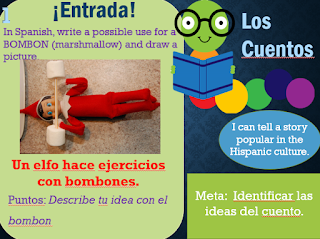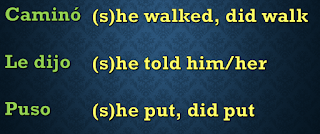This is our intro unit
for Level 3, 10th Grade. We make the goal clear from the beginning with
our students. We're doing a unit in which they'll have to retell a story
popular in the Hispanic culture at the end at Intermediate Low. So we
created a unit with Backward Design in order to build them towards a successful
presentation. We set daily learning targets and try to hold the students
accountable each day with closure in regards to that goal.
Since the students will
be doing an oral performance piece, we incorporate a daily "practice
speaking" and ask that they be true to the goal which is to only
speak Spanish and not use English. We label the activity with a yellow
star (I'll use * in my plans) and always remind them the purpose of that
activity which is connected to their final performance piece.
Day & goal:
1: pre-exposure to past
tense movie talk Cacto
2: students engage with
text from movie talk
3: focused past with
structures le dijo, caminó, puso
4:
characters and settings in stories
5:
American story
6:
Intro Silbon (setting)
7:
Intro essential elements in Silbon
8:
Silbon story
9:
Silbon analysis (IPA practice infograph reading)
10:
work on details in story to prepare to retell
11:
Final evaluation
12:
celebration if earned
Also - it's our first
time going deskless, so our plans focused on being intentional with that
goal!
Day 1:
1. Administration:
Meta: Identificar las ideas del cuento.
Frases: Describe tu idea con el bombon
Entrada (warm-up): On your whiteboard, write a possible use for a BOMBON (marshmallow) and draw a picture.
2. Cuento
a. Movietalk https://youtu.be/CcO7MU2PmXc
b. comprehension check: True/False (I ask for thumbs up or thumbs down to scan the room and see how students are doing)
c. retell with written words (the same story written on powerpoint so I can use my pointer and have students help translate and do some focus on grammar such as noting "ó" tells us he/she did...so what about "aron" that we see later in story.
3. Enfoco Gramatical
a. "notes"
b. whiteboard cloze
c. *follow-up questions (Que vio? con quien? porque? que proteccion tenia? cual otra actividad hicieron?)
4. Evaluationa. identify four places
b. use places to complete "evaluation"
students can self-correct and turn papers in so teacher can see scores
Day 2:
1. Administration:
Meta: Identificar los detalles en el cuento
Frases:
Entrada (warm-up): quizizz
2. Cuento: Textivate: https://www.textivate.com/r9lkn1
a. model the options so students know their options AND share this is an opportunity to engage with the text to prepare for the evaluation at the end of class
b. students work 25 minutes
3. Detalles
*Students get speaking cards. Partner A reads statement (all are false) and partner B gives the corrected idea. Switch
4. Evaluation: Cloze
Day 3:
1. Administration:
Meta: Poner los eventos del cuento en orden
Frases:
Entrada (warm-up): whiteboard translations
¿Dónde ocurrió el cuento?
¿Qué pasó en el cuento?
¿Quién era el personaje?
¿Cuál era el conflicto?
2.
a. acciones (we're introducing some TPRS) teacher show word and charade and "play" a bit with the charades (add adjectives....fast, slow / make do 2 in row...3 in row )
b. story with actors
3.
 a. libro - T read like movie talk making changes to support the TPRS words
a. libro - T read like movie talk making changes to support the TPRS words
b. ask some comprehension questions
c. visuals - Teacher dictate and students draw (whiteboards), pausing after each 2 to allow students to try to retell*
Fergus vio un gato.
Fergus vio un gato.
El hombre caminó con el perro.
Él le dijo “Ven aquí”
El lo puso en la bañera.
El lo puso en el auto.
El señor le dijo “buenas noches Fergus”
d. post all options in DIFFERENT order and have students write the sentences to the correct drawing
4. Evaluation: write numbers indicating the correct order of story
Day 4:
Meta: Identifica locaciones y personajes tipicos en un cuento
Frases:
Entrada (warm-up): quizizz (this is one of those ones that I got a reaction to that makes me know CI is right...a student was completing and said "I didn't even know I knew these words")
2. Personajes y Locaciones (CI notes)
a. dedos: teacher describe and students use fingers to identify which character teacher describe
b. whiteboards: number 1-6 and teacher give CI and students write the character
 c. *speaking activity: describe the characters on whiteboard (encourage IL goal: simple sentences for each description)
c. *speaking activity: describe the characters on whiteboard (encourage IL goal: simple sentences for each description)
3. Video Musical
a. escribe todo lo que ves (they can do whiteboards)
b. Teacher call on EVERY student and write ideas on board in front
c. Edpuzzle
4. Evaluation We put a "quiz" on schoology (our learning management system) very similar to Edpuzzle
Day 5: NOTE: this is a day for them to practice for their final presentation and get teacher feedback
1. Administration:
Meta: Narra un cuento americano con detalles
Frases:
Entrada (warm-up): Gimkit
2. Cuento Americano (we did Little Red Riding Hood)
a. T read and students guess
b. listen for evidence 2nd reading
c. what is: setting main characters, locaciones, conflict, solution, purpose
d. give written version of story & highlighters: Ss highlight all they know and then go over
e. *speed dating with screen shots (we put descriptions on the back so the person holding the picture could be an "expert" and help out if need)
3. Evaluation: Students need 20-25 minutes to do this on Flipgrid since it's the first time this year!
Day 6:
1. Administration:
Meta: Describe el escenario del cuento hispano.
Frases: Que es una leyenda?
Entrada (warm-up): Escribe 8 ideas que ves o asocias en la foto
2. Origen
a. Pais o Ciudad o Continente?
b. Locacion de Venezuela (we gave a WS of central and south america)
c. comprehension check (cloze on WS)
d. *picture talk (we got a lot of pictures showing Los Llanos)
3. Video Musical (possible link..having probs with YouTube)
a. watch and write all you can see
b. Teacher call on all students and write on front...volunteers with any to add?
4. Evaluation: What does Los Llanos have to offer as a setting for the famous Venezuelan legend? (we let them answer in English)
Day 7:
1. Administration:
Meta: Identifica objetos usados en el cuento
Frases: Que sabes sobre la locacion del cuento el Silbon?
Entrada (warm-up): Usa los visuales para responder cierto o falso
1.
Hay evidencia de la naturaleza.
2.
Sólo hay una persona.
3.
Los visuales representan música.
4.
El silbón lleva un sombrero y un traje.
5.
Él tiene dos sacos.
6.
La mujer en la casa está cocinando.
7.
Se nota violencia en tres escenas.
2. Escenas
a. "museo" We go on an excursion and leave the classroom! Students are to look for actions, locaciones, characteristics
b. chat: I call on random students to report out and then I provide more CI
3. Objetos
(our focus to help prepare: Cuchillo, Hueso,
Olla, Órganos, Palo, Perros, Ropa vieja y rota, Saco, Silbido, Venado)
a. teacher description: We all gather around the table in the middle to see what I have. I leave all objects in the giant "pot" for an suprise element. As I pull out, I describe and ask some questions (thinking about giving them ideas and vocab they'll need for next idea)
c. word maps: we again left room and went other way and put partners at a paper that had a word written on it (from the objects) and asked them to write 2 words they associated, rotate and repeat, sometimes I have them read only...not write and then skip to next
d. Picasso paper plates: hand out paper plates and a secret word (from the objects) and then students have to draw it...but paper plates go on their heads!!
e. *turn and describe your "art"
f. repeat if time with new word
4. Evaluation: Identify 5-8 objects used in the story (in Spanish and they can write on that plate!)
Day 8:
1. Administration:
Meta: Dar el orden correcto de los eventos con detalles en el cuento.
Frases: Describe un objeto usado en El Silbon
Entrada (warm-up): Quizlet learn mode (then Quizlet live after time up)
2. Cuento
a. Teacher tell with pics (we use the bottom part of their practice IPA reading they'll get the next class)
b. Work with partner to put in order (we cut and give partners an envelope)
c. Review correct order
d. (have them scramble like they're putting them away) Repeat order
e. *comprehension questions
3. Evaluation: WS with scrambled sections to write numbers in order
Day 9:
1. Administration:
Meta: Identificar elementos de una infografia del cuento
Frases: Que ocurre en el cuento El Silbon?
Entrada (warm-up): Textivate
2. Cuento
a. *speed dating with pics from museo (we wrote some expert ideas on back). Student describes their own picture...pointing to help partner understand
3. Infografia:
a. this is their very first
b. go over and share how to grade using rubric and let them self-assess
4. Evaluation: part 3 and turn in so teacher can quickly give rubric feedback
Day 10:
1. Administration:
(note: pass back practice IPAs which we provided rubric feedback and describe which ideas would have earned maximum points)
Meta: Describe partes diferentes del cuento
Frases: Cual importancia tiene El Silbon?
Entrada (warm-up): (let them listen to El Silbon whistle) and decide cierto o falso
1.
El sonido es el piano
2.
Tiene un aspecto misterioso
3.
Hace un eco
4.
Tocó por mucho tiempo
5.
Era fuerte y ruidoso
6.
Causa miedo
7.
Es musica bailable
2. Preguntas
a. *chat with partner and Teacher will call on "victims"
b. go over
c. Achi Pachi... do you know this? So fun! Trick them into practicing and repetition. My friend Senorita Walpole wrote a blogpost about it
3. Descripciones
We made *dominoes and students worked in groups of 3 to form sentences about the story (example: I connect the end of my domino "el abuelo" with the piece on the playing area "torturar" and I say "el abuelo queria tortura el nino con un palo de un arbol). This was great...some kids would use 3 pieces to form a sentence!
4. Evaluation: Writing evaluation:
Summarize
El Silbon in Spanish. You may wish to
include:
-type
of story
-characters
-setting
-story
events
-moral
/ goal / theme
-cultural
perspectives / comparison
Day 11: FINAL
1. pass back sample writing to see what level teacher marked and her supporting evidence
2. practice Flipgrid:
Summarize 3 parts of El Silbon in Spanish. You may choose from:
-type of story
-characters
-setting
-story events
-moral / goal / theme
-cultural perspectives / comparison
3. Transcribe: We've updated and it seems like this may be it!
4. complete final
Day 12: Celebration (they won our competition)
I bought La Llorona movie from Amazon since we did want to include this legend but only have so much time.
Hand out reflection sheet.
Note: if students aren't happy with their grade, they may redo. They must do a transcription of their final video and meet with teacher to see what area needs improvement.















No comments:
Post a Comment